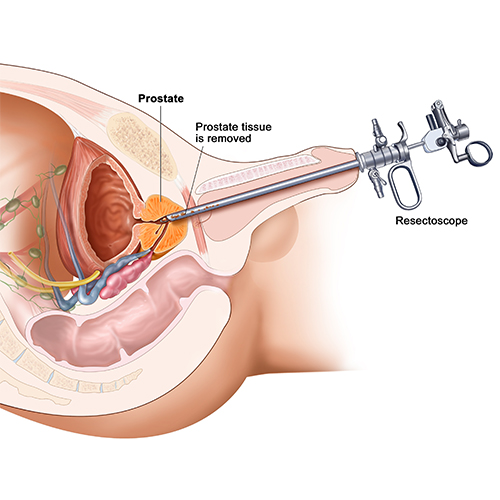TURP Surgery
TURP (Trans Urethral Resection of the Prostate)
Transurethral resection of the prostate (TURP) is a urological procedure used to treat benign prostatic hyperplasia (BPH). TURP surgery is also known as resectoscope procedure.
During TURP Procedure, an instrument is inserted up the urethra to remove the section of the prostate that is blocking urine flow. It is often used to treat prostate enlargement (benign prostate hyperplasia).
Reasons for TURP procedure
- Problems with starting urination.
- Having to urinate more frequently at night.
- Hesitancy.
- slow or diminished force of stream.
- Having an urgent need to urinate.
- Dribbling after you finish urinating.
- sensation of incomplete emptying.
- Blood in the urine.
TURP Procedure (TURP Surgery)
A TURP is performed under general or spinal anesthesia, so you will not feel any pain during the procedure.
Resectoscope is passed into the urethra. It cuts out pieces of tissue from the prostate that are bulging or blocking the urethra. An electric current is passed to loop and generate heat, and the heated wire is used to cut away the section of prostate.
The doctor will insert a catheter into the bladder to empty urine.
TURP procedure time depending on how much of prostate needs to be removed.
Recovery Period
Patient can leave hospital two to three days after surgery.
Resume most normal activities within one week.
Advantages of TURP Procedure
- No longer problem of starting urination.
- stronger force of stream.
- decreased need to push.
- More in control of holding your urine in.
- No need to get up in the night to urinate as much as you used to.
- Stronger stream of urine.
Advin TURP SET / Resectoscope SET
We, Advin Urology, provide international quality standard products for TURP / Resectoscope Procedure.
- TURP Working Element (Active / Passive).
- TURP Rotatable Sheath.
- Inner Sheath.
- Outer Sheath.
- Obturator.
- TURP Loops.
- Cutting Loop.
- Cold Knife.
- Kollins Knife.
- Roller Electrode.
- Ball Electrode.
- High Frequency Cable.
- Visual Obturator.



